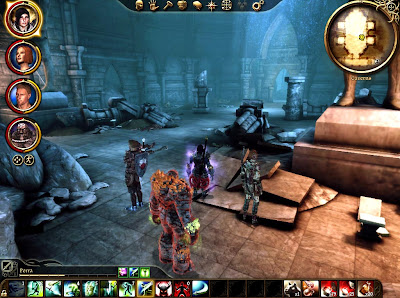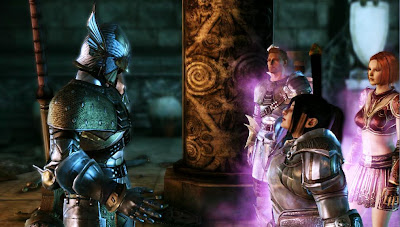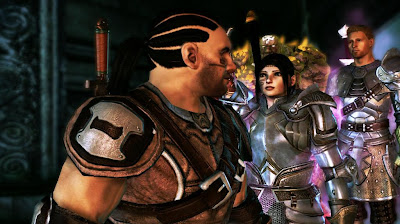 |
| So ... dragons. I'm thinking they're significant, yes? |
Perra's quest for the Urn of Sacred Ashes comes to an end. Surprisingly, this search for a human religious artifact forces her to reflect on the dwarven life she's left behind and who her future self will be.
As an Aside - Look! No Snow! See? I was not kidding. Now why on Earth did the cultists not store their priceless ancient documents up here away from ice and improbable snow drifts? I just don't get it!
Dragons in the Dungeon - It is in these caverns that our heroes discover exactly what the cultists are a cult of. Presumably they worship dragons. Cages for dragons, sheep carcasses, and tables of dragon eggs fill the caverns adjoining the Ruined Temple. Meanwhile hordes of dragonlings, handfuls of drakes, and armies of cultists accost Perra at every turn. Who knew that a supposed place of worship could prove so treacherous?
Of Cultists and Andraste - Perhaps the most frustrating part of the cavern trek is Father Kolgrim. The leader of the Disciples of Andraste, he curses Perra for slaughtering the faithful and swears that Andraste will bring vengeance down upon our band. This makes me laugh every single time. He accuses them of slaughtering the faithful when it was the so-called faithful who began it all. Prior to the arrival in Haven Kolgrim's followers had granted death to at least one knight, one scholar, one adventurer, and one Templar. They also tortured Brother Genitivi with plans to kill him. Brother Eirik made it quite clear that they considered most everyone who trespassed in their village a threat (and thus a kill) and Father Kolgrim himself is clearly fighting down the overwhelming instinct to slaughter Perra and her band of merry men on the spot. The hypocrisy of Kolgrim's accusation never ceases to amaze me. I've tried to look at the situation from his perspective but I simply can't. Perra was right when she called him delusional. That's clearly what he and his dead followers are.
 |
| "Andraste" the Dragon |
Of Andraste and Religion - When asked about Kolgrim and his followers, the Guardian makes a very telling statement. The cultists, he tells Perra, focused on Andraste and forgot that she was simply a mortal prophet. In worshiping Andraste they ignored the Maker for whom she was a tool. (I've been trying to find the direct quote online with little success. Apparently I was the only one really moved by his little speech.) According to the Guardian, the cultists turned Andraste into an idol and their excessive worship of her corrupted over time until they forgot the real Truth. This corruption led them to believe that the dragon was Andraste reincarnated and resulted in what Perra et.al. encountered upon arriving in the Village of Haven. If you really sit back and think about it, the implications of what the Guardian says are massive.
You know one thing I really appreciate about the depiction of religion in DA:O is its multi-dimensional nature. The story does not call the Chantry evil nor does it elevate it to a saintly status. Both good and bad priests exist, but the genuinely righteous priests out number those that are corrupted (Kolgim falls in with the latter). Throughout her journey in Fereldan, Perra meets individuals who are all in completely different places of their personal spiritual journey. Some like Alistair have a bone to pick with the Chantry. His issues, however, don't mean that he has denounced his faith. Some like Leliana have come to the Chantry late in life and found it to be a place of solace and refuge. Others, like Morrigan, will have nothing to do with it at all - ever. Even the player has an option of being completely devout, on the fence, completely against it, or anywhere else in between. As someone for whom religion plays a very important role in everyday life, I appreciate the manner in which Bioware wrote this aspect of the narrative.
Confronting the Guilt - Speaking of the Guardian, Perra and Friends find themselves face-to-face with him after defeating Kolgrim. The Guardian looks into their souls, makes them confront their pasts, and then warns them that they can only see the Urn after proving themselves worthy. This worth is achieved by passing tests within the Gauntlet.
At this point, DA:O brings Perra's Dwarf Commoner origin back into play. When she became a Grey Warden, the Guardian states, Perra left a family behind that relied on her. "Tell me pilgrim, did you fail them?" he queries. Perra has six optional responses that range from rudeness ("My answer is my own, Guardian") to regret ("Yes. I should have done more to get them out of there.") In the end though Perra chose to reconcile with her past. "No," she told the Guardian, "Even if I'd stayed, they would still be miserable." The truth of the matter is that if she'd stayed, she would be dead. A dead woman cannot help the ones she loves. At least as a Grey Warden she can keep the darkspawn at bay and make the world a safer place for her family. This realization is a major turning point in Perra's story. Her family will continue to have some sway over her decision making, and likely always will, but she can't keep beating herself up for leaving Rica behind. As "Leske" tells her in a moment, she needs to move on.
Confronting the Past - As reinforcement for Perra's discussion with the Guardian, the Gauntlet's second challenge is a self reflective two-parter. As soon as they enter the second chamber Perra comes face to face with a spirit bearing the personality of her former partner in crime - Leske. There are a number of ways she can greet him (and a number of ways he can respond) but it always ends in one fashion. Leske informs our protagonist that since she left Jarvia has been very angry and constantly on Leske's back. One is left with the impression that Jarvia tortures him continually in some fashion. Whether this torture was/is physical or mental is unclear. Even so, Leske continues. He's glad that Perra got out and has moved on with her life. This conversation makes our hero confront the life that her friend has been forced to lead since she left, but also reassures her that she made the right decision and he's glad that she has moved on.
Being Reborn - The second part of this challenge pits Perra and friends against shadow/spirit versions of themselves. By fighting and defeating her clone our hero commences the final "moving on" steps. Through killing herself she metaphorically kills the guilt and regret that has tied her to life in Dust Town and redefines herself as Perra the Grey Warden. The Gauntlet's third challenge, working with her companions to construct a bridge across a chasm, allows Perra to quite literally build a bridge between her old and new life. After cementing her new identity in this manner, she progresses to the Gauntlet's last phase - purification by fire. Walking through the holy fire in her birthday suit burns away any emotional remains left from previous tasks and, like a phoenix, gives birth to her anew. Only once she has become a new person can she approach the Urn of Sacred Ashes. The Guardian told Perra that the Gauntlet proves she is worthy of approaching the Urn. In her case, however, the Gauntlet goes above and beyond its intended purpose.
Dwarf Commoner vs. Human Noble - I must admit that Perra's conversation with the Guardian and the final stages of the Gauntlet had a real emotional impact on me this time around. In previous playthroughs the Gaurdian forced my human noble to confront the fact that she had left her parents to be slaughtered by Howe's men. The spirit from her past, however, was her father with whom she'd had a wonderful relationship. Unlike Perra's Leske who is still alive (we know this from her quick visit to Orzammar), the human noble's father was already dead. Thus, instead of being a tool to push one out of the past and into the future; the father's spirit provided a bittersweet moment of reconciliation. When the human noble last saw her father he was bleeding to death on the pantry's floor. She hated to leave him, but she knew he was past saving. If one considers the amount of time that must have passed between the origin story and this moment (taking nights in camp and cross country travel on foot into consideration) one can easily assume that the human noble would have already reconciled herself with her father's fate. Seeing his spirit one last time simply provided closure and allowed her to remember him as a whole individual instead of a mortally wounded man covered in blood. Given this different perspective, the Gauntlet always seemed like a series of tedious tests to me and little more. Playing through with Perra honestly made me regret having taken so long to finally RP DA:O as a dwarf.
Coming Next- Perra and her companions deliver the Urn of Sacred Ashes to Arl Eamon to see if he can be cured.





No comments:
Post a Comment